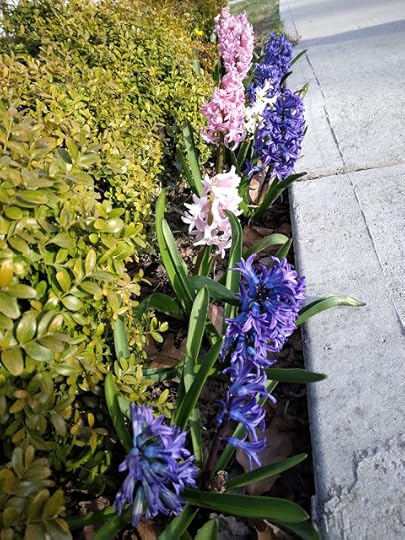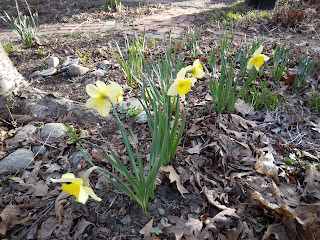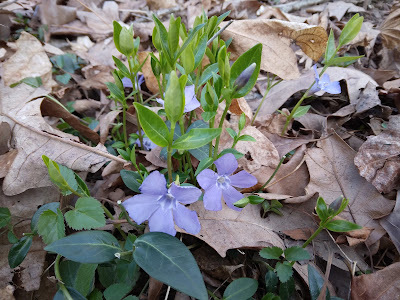Robert Knox's Blog
May 1, 2024
Publishing Karpa Talesman: A Long Journey to a New World
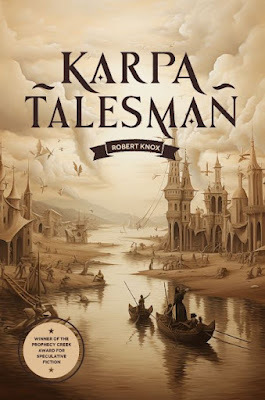
What a blessing, it turns out, to be born on Earth where – atleast in some places, at some times – concepts of justice, fairness, and protection of the weak are honored in both law and practice. What a joy, thenovel’s hero Karpa – returned to his former existence as Copper Drey – discovers,to be home again. Life on Earth, with all its flaws and disappointments, isstill worth living.
This bookhas turned out to be a kind of life’s work. Though I only began it until well into middlelife, it was the first of my efforts I judged worthy of a serious push for publication.And, remarkably, I found a literary agent willing to take it on, for a shorttime. His efforts failed, fortunately, in retrospect, because the manuscript I gave him provedto be only a first shot at the bull's eye.
I went on to other projects, and my next effort to achieve publication was undertaken in behalf of the history-based novel Suosso’s Lane, whichtells the story of the Sacco and Vanzetti case and wraps an invented tale abouta contemporary search for ‘lost evidence’ around it. Though the effort succeeded, that book’s publisherturned out to be a very poor choice, and only my own speaking efforts generated sales.
Some time after my Suosso’s Lane, tour of Eastern Mass. libraries, while I flirted with otherprojects, something caused me to take another look at Karpa. What the bookneeded, I decided then, was second storyline – not a subplot, so much as a focus on theongoing, but deeply fractured life on Earth (not Urth, where Karpa struggled to stay alive) endured by Karpa/Copper’swife and daughter. I had to show why Karpa’s efforts and, it was to be hoped, the ultimately successful conclusion of his mission, mattered to people – real people, potentialreaders, and not simply people like me who enjoyed the head games my narrative voicewas indulging in.
So I addedthese back-on-Earth encounters, developed the characters of Copper’s wife anddaughter as they struggle with what’s happened to their husband and father on topof what’s destroying the coherence of their world, and upped the ante on the long odds against Copper/Karpa’ssuccessful retrieval of the wisdom needed to allow Earth to right itself. Then, satisfied with these improvements, I wondered what I should do with the new MS. I had tried hard to find to find anagent for Suosso’s Lane – a story with an attractive hook: a genuine tale of injusticecommitted by the strong against the weak – but in the end failed and was leftwith an uncomfortable bond with an ill-fitting publisher.
Maybe thistime, I told myself, I should focus directly on finding an appropriatepublisher.
Searchingfor a publisher, in case you’ve never tried it, is a lot worse than, say,looking for a job. Other distractions took precedence. A novel based on working for a localnewspaper. A novel about young people fresh out of college and sharing a house.A novel about a would-be dictator trying to take over the country.
Then one day,reading a writing/publishing industry mag, I came across an ad by a publisherseeking entries for manuscripts in various genres: mystery, adventure, women’sfiction. Oh, I thought, and here’s an interesting genre: speculative fiction. Well, said self to self, I think I have one of those.
I’ll justgive the MS quick brush-up and proof-read, I told myself. If you’ve ever satdown with a book length MS to proofread, you may think it’s going to take acouple of hours, but it ends up taking a couple of weeks. Or months.
Eventually, I traveled to the ends of the Urth with Karpa sufficiently comfortably (and often) to judge the novel MS was ready for prime time consideration. Months after I submitted the MS, the publisher called me up to say that my novel had won the competition, if it was still available for publication. I did not pretend that other publishers had been food-fighting over the right to publish it.
Shortly after publication rights were secured, Covid walked among us. The world seemed to stop turning. (Maybe Copper/Karpa should have been dispatched to the stars again to see what was up.)
I cannot say how happy I am that my speculative fiction travel narrative has finally seen the light of day.
It's almost enough to make me want to write another one.
April 4, 2024
Karpa Talesman -- My New Novel! -- Just Launched Last Week
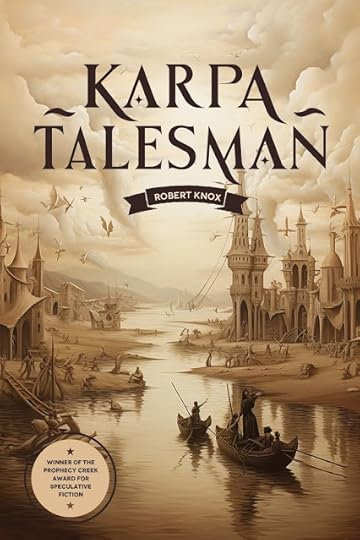
My newly published novel KarpaTalesman – just out a week ago (March 2024) – is the winner of the ProphecyCreek Award for Speculative Fiction. Speculative fiction, sometimes called a“super genre” is a literary approach to storytelling that makes use of thethemes and devises of the sci-fi, fantasy and even fairytale genres to tell adeeper story about life in troubling times.
The seeds of Karpa Talesman wereplanted in an experience of serious illness, a complex surgery, and thehallucinatory dreams planted by the anesthesia needed for the surgeryaddressing two types of life-threatening cancer.
The idea for the book blossomed duringmy recovery, while I split my time between freelance newspaper work andfollowing the fictional trails where these dreams led me. Years of writing, anddeep revisions, followed.
Here's the short take onthe book that resulted:
Planet Earth appears to be running out of the dimensionof time itself. Children go to school in the morning, but in the blink of aneye the day is over, and they are lining up to take the bus home. ScientistSheena Drey takes her daughter to the park, but darkness arrives before theycan find their favorite tree. Convincedthat the multiverse contains infinite worlds similar to Earth, scientists ofthe Dream Project send gifted “dreamers” to search for a universe where thesolution to the problem can be found. Sheena is shocked to learn that herhusband, Copper, a self-described 'dreamer,' has volunteered for the projectand is lying in an induced coma-like state in the project's lab.
Where Copper's dreams take him, the planet where he no longer knows himself,and his inward – and outward – journey to find his way back to the world – andthe family – he left behind is my novel's through-story. Copper's journey,experienced by the dream-self known as Karpa Talesman, becomes an explorationof primitive and advanced civilizations that provide the wisdom and the cluesthat will ultimately enable Earth to save itself.
"Karpa Talesman" received advance praise from novelist Patry Francis,author of The Orphans of RacePoint” and All the Childrenare Home: “Whether he’s writing a historical as he did with Suosso’sLane, or veering into science fiction as he does with in his bold newnovel, Bob Knox has a unique ability to tap into the zeitgeist of the time, toshow us not only who we are, but who we might become. I loved this book for itsprescience and originality, the sheer fun of playing with language, but most ofall for the compassion and wisdom that floods a dark world with light."
The book is available as a paperbackAmazon.com. Here's the link KarpaTalesmanPlease take a look at Karpa Talesman!
December 11, 2023
Still Eager to Hear About Sacco and Vanzetti, at Whitman Public Library
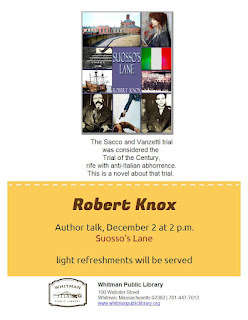
The program room at Whitman, Mass. Public Library filled steadily, until more chairs had to be separated from a file a pile in the far corner of the room and placed on the floor to accommodate the audience for what librarian Barbara Bryant called "the best-attended author talk we have ever had!"
The talk about Sacco and Vanzetti was her idea, her invitation. I hadn't given a talk about the two Italian immigrants falsely accused of murder and robbery back in 1920, and ultimately executed by the state of Massachusetts seven years later despite worldwide protests -- for half a dozen years. I gave a bunch of them, mostly in libraries, after the publication of my novel based on the case, "Suosso's Lane."
The audience that filled the Whitman library program room was almost uniformly of an age to know that we're all part of history now.
This talk was about the facts of the case, not directly about my book. The book is fact-based, but goes beyond the historical record to invent a contemporary (wholly fictional) investigation to turn up some new evidence about the old case. Those talks were fun, but a little fraught -- I was hoping back then to sell books.
To prepare for this talk, I had to go back to my notes and printouts for those talks from seven years ago and reacquaint myself with what I used to know well enough to share by memory with an audience, Facts, dates, places, names were particularly important, indeed essential, because this was a talk about the case, its history, rather than about the book.
Here's what I told them, the good people of Whitman, about the Sacco-Vanzetti case, the international affair that exposed America's prejudice against immigrants, particularly those from Italy.
By Robert Knox
These are difficult days in American politics – perhaps difficultdays in America, period. But times were tough a hundred years ago as well,especially for immigrants and for civil liberties – i.e. constitutionalprotection of free speech and other basic rights.
A little more than a hundred years ago, on April 15, 1920, thecrime took place that began the notorious Sacco and Vanzetti case – an Americanscandal of injustice that became an international cause – in which two Italianimmigrants who professed anarchist beliefs were accused without a shred of realevidence of committing a heinous crime, tried in a prejudiced courtroom,convicted by a nativist jury – that is to say, all male American citizens in a timewhen only men could vote – and eventually executed 7 years later, by which timetheir case had become an international cause de celebre. (They were famousnames worldwide, everybody knew about the case; everybody worldwide knew theywere victims of injustice.)
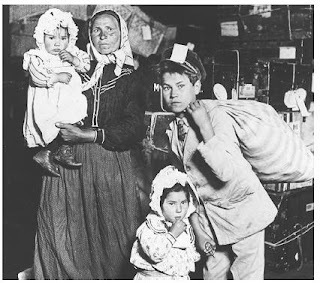
Immigration, always an essential part of the American story, lookeda lot different in the early 20th century. Immigrants came fromEurope – not from Mexico, Central America, Asia, the Caribbean, Africa or theMiddle East, as they do today. They came at first from England, Scotland, Ireland,Germany, Scandinavia, mostly northern European countries. But from around 1880 andinto the 1920’s, in greater numbers than had ever been seen, they came fromsouthern and eastern Europe. From Poland, Russia, the Balkans, Portugal,Turkey, and – the single greatest number – from Italy. For those who came from Italy,the cause was almost always purely economic. Disasters weakened the economicbase of Southern Italy: drought, crop disease, the collapse of traditionalfisheries and the lumber industry. At the same time advances in maritimetransportation made it easier, and less expensive, to cross the ocean. Many Italianmen crossed the ocean to work in seasonal industries and then return home withtheir earnings year after year. But many others, including women and children–whole families – chose to come and stay.
During those peak decades, 1880-1920, national prejudices grew asnumbers of immigrants did. Some towns or companies made it clear when they werehiring more workers that they did not intend to hire Italians.
Two immigrants: Bartolomeo Vanzetti arrived in America in1908 as a young man of 20 to “put an ocean between my mother’s death” and therest of his life, he said…. Unlike most, he did not come for economic reasons.His father was a wealthy farmer in northern Piemonte Italy (in Villafilletto) whowanted Bartolomeo to learn to run his businesses. He sent him to the city tolearn to be a pastry chef and help the family business that way. Bartolomeofound pastry-making to be factory work, piece-work, a miserable business inconditions that nearly killed him. He became seriously ill with a breathingdifficulty, was sent home, where his mother devoted herself to nursing him backto health. Then she developed cancer and died after months of suffering. Herdevoted son thought that her efforts to save him weakened her. Wishing toseparate his future from a painful past – he had a deep relationship with hismother, but a poor one with his father, he decided to go to America, which hethought of as “the land of the free.” No big divides between social classes; nooppressive national church.
Vanzetti was not an anarchist when he arrived. His life in the USled him to that philosophy. He later told reporter about the early years, “Iwas a Dago to be worked to death [a pejorative]…. We lived in a shanty, wherethe Italians work and live like a beast…” Like other day laborers, he is forcedto follow the availability of work, a trade he called “pick and shovel.” Afterfive years mostly in New York, rumors of work brought him to Mass., andeventually to Plymouth, where he boarded with the Brini family who came fromhis region in Italy, and who lived in North Plymouth, the immigrant section oftown. [this is how I got interested in the story...working for communitynewspaper publisher based in Plymouth] He became close to the family’schildren. He called Beltrando Brini his “spiritual son.” Recorded interviewscollected and published later show V. to be kind, courteous to women, gentleand loving to children; V was a talker, a thinker, a dreamer, a reader. Among thebooks he owned was “the life of Jesus Christ” by Ernest Renan. Anarchism becamehis religion; its ideals gave meaning to his life… Among his jobs was workingon repairs to Plymouth harbor.
Nicola Sacco was born in the town of Toremaggiore (SE of Italy) andemigrated to US in 1908 at age 17. He loved machinery. He emigrated with hisbrother Sabino, and when his brother returned to Italy in 1909 and he was leftalone in the United States, he began to take lessons on shoe-trimming andbecame an excellent shoe trimmer. He was a skilled worker; made a good living. Hemarried his wife Rosa, when he was 21, she 17, and first child was born in1913.
He found settled work in a shoe factory in Stoughton, Massachusetts;he developed a strong relationship with the owner, the son of an Irishimmigrant. He made a good living because he was so good at what he did. A shoetrimmer is piece work. He could make a day’s pay in a few hours. He was alsoattracted to the cause of labor, and participated in strikes. …Sacco helpedwith the defense of Arturo Giovannitti, an Italian labor organizer -- one ofthe principal organizers of the famous 1912 Lawrence textile strike -- anItalian immigrant who had been arrested on a dubious murder charge. Itwas one of his first radical activities.
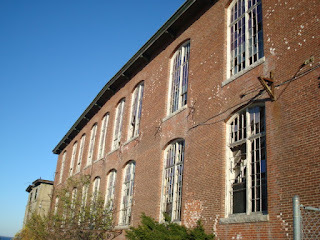
A definition: The word “anarchy” means ‘no authority.’ [From theGreek: ‘a’ means not; archon is a ruler] It doesn’t mean chaos. It means livingwith no governing state, no political or “established” religious institutions.No rich; no poor… V. called anarchy “the beautiful idea.” People, he believed,would live happily and survive materially by forming voluntary cooperatives. Sharingresources. Recognizing the needs of others as important as one’s own.
For anarchists like V and S and for many other social critics, thefundamental issue in this stage of western civilization was “rich versus poor”.…today we call that “the distribution of wealth.”
Believing that workers were oppressed by the capitalist system, by theowning of property, anarchists like Sacco and Vanzetti – both became disciplesof the anarchist theorist Luigi Galleani (V. called him my ‘master’) –supported and took part in strikes. Though he did not work there, Vanzetti tookpart in the 1916 strike against the Plymouth Cordage Company, a largeropemaking business. WWI created a great demand for American resources such as cordage,but war-driven inflation ate up workers’ earnings.
When America joined the war in 1917 (3 yrs after it began), the actforced political radicals to choose: participate or not? Anarchists opposed allwar; they opposed the draft; they opposed governments.
Sacco, who supported strikes by his physicalpresence – strikes were often street battles – also became a disciple of Galleani. He began attending weekly meetings of an anarchist group in 1913 and subscribedto Cronaca Sovversiva (“Subversive Chronicles”), as didVanzetti, an anarchist newspaper published by Galleani in Italian. He becamea devotee of Galleani and in the next several years wrote for the paper, donatedand solicited funds for anarchist activities, as well as support his family.
So the two men have much in common, aworld view, an allegiance to the views of a powerful theorist, or ideologue inGalleani. A strong commitment to social change. They’re the kind of people thebusiness and political establishment hate and fear. They want change. Asanarchists see it (or ‘radicals’ generally), the ‘establishment’ hates change;it wants to preserve the status quo. The owners and the politicians are rich;they don’t care if you’re poor.
The two meet at activities held in opposition tothe war. Then, in 1917, both join a group of men leaving home to travel toMexico and live under pseudonyms in order to avoid the draft.
The Mexico experiment lasts a few months. No jobs;no money. Then both men go ‘home.’ Sacco returns to his young family, in Stoughton,Massachusetts, where he worked for a shoemaker, who valued him so highly hegave him management responsibilities and paid him to keep an eye on the factoryafter hours. Vanzetti goes back to Plymouth; has to find a new place to board, theBrini family doesn’t have room for him any more. He boards with a widow a fewstreets over in North Plymouth. He also finds a new to make a living; sellingfish, door to door, among the immigrant community.
OK, now comes the heavy political stuff.
During a period of anti-radical andanti-foreigner hysteria known as “The Red Scare,” [ask yourself if this was inyour American History class] a well-organized criminal gang carried out abrazen daylight robbery in Braintree, Mass. The robbers stole a shoe factorypayroll and shot and killed the paymaster and his guard at point-blank range.
We'll come back to the crime, but first we have to talk about the Red Scare of 1919–1920 — a time of nationalparanoia in which thousands of immigrants were detained without dueprocess of law.
After the US entered World War I in 1917, Congresspassed laws to suppress all criticism of government’s decision to join theongoing European slaughter or any means the government chose (such as the draft) to conduct the war.Anti-war critics were prosecuted, the non-citizens among them deported to theirnative countries. (For comparison, imagine that response to war protests andcriticism of the government during the Vietnam War era.)
When Galleani was deported to Italy, some of his followers‘declared war’ on the government – arguing that the government had already beenmaking war on them -- on the institutions that suppressed their publications,broke up rallies of war critics, and used the courts to suppress their FirstAmendment freedoms of expression. In response, these followers – some of themmembers of the same ‘gruppo’ that Sacco and Vanzetti belonged to -- sent bombs through themail and placed them at the homes of their ‘enemies’ in government and bigbusiness. These "Anarchist Fighters" were self-declared enemies of the state.
In his recent book “American Midnight,” historian Adam Hochschilddetailed the US government’s outrageous violations of war critics’Constitutional rights – and the rights of Americans in general. Thousands ofimmigrants were rounded up in mass raids, declared ‘disloyal’ and sentenced todeportation before a single federal judge stepped in to overturn decisions madewithout due process of law.
His legally prescribed role was to make sure "due process" had been followed before he approved the deportation orders. He refused: dueprocess had not been followed.
A crackdown on labor organization was taking place as well: Union meetings werebroken up by local and government police; speakers, and simple participants,dragged off to jail… A lawless war was declared on members of the most active labororganization of the time, the IWW, the Industrial Workers of the World, knownas Wobblies. Private industry, especially 'big business' supported the war. There was lots of money to be made from it. Organized labor -- unions -- cut into their profits. Now that the US was at war, big business wanted union organizers to be seen as traitors.
Wartime deportations included the nation's most famous critics of capitalism, among them Emma Goldman, a Russian immigrant, radical, anarchist, and America’s most popular lecturer. She traveled wholecountry, drawing audiences everywhere and speaking on a wide range of social and political subjects.
Eugene V. Debs, not an immigrant but a Socialist party candidate who received almost a million votes for President in 1912, was jailed for opposing the decision to go to war.
Mobs of what were called“Super-Americans” physically attacked and broke up meetings of war critics, draft critics, and labor organizers. Enforcing wartime restrictions on freedom of speech and assembly required the creation of the first federalpolice force, called the Radical Division of the Department of Justice; it later became theInvestigation Bureau; finally the FBI, its principal duty from the very beginning being to ferret out and suppress 'subversion' by labor organizers or 'radical' critics of the status quo. J. Edgar Hoover, in his 20s was there from the Red Scare to the Civil Rights era when his agents were harassing leaders such MLK.
After the government suppressed Galleani's network, destroyed his printing press, burned his writings and tried and deported the maestro himself back to Italy, his followers decided they had to fight back. Going underground, hiding their identities, they formed the "Anarchist Fighters" and mailed bombs to the houses of federal judges, police chiefs and prominentcapitalists, "terrorist" style, in revenge for the 'war' the American government had been waging on them. Famously, June 2, 1919, bombings in major cities such as Washington DC and Boston shook the nation. Top of the page was the bomb that exploded on the frontsteps of the Attorney General A. Mitchell Palmer’s house in DC, destroying most of thehouse but not harming the family. Other buildings were destroyed, but almost no onewas seriously hurt, except for the anarchist who blew himself up when the bomb he was planting at Palmer's house went off prematurely. Remarkably, we know his name, Carlo Valdinocci, an Anarchist Fighter and follower of Galleani. Sacco and Vanzetti would have known him.
Thesebombings lead to the "Palmer raids," as they are known, in late 1919, when federal agents and vigilantesconduct major raids in big cities rounding up supposed radicals and thousands ofimmigrants – lots of Russians, since after the Russian Revolution ‘communism’ is now perceived as a majorthreat. Detainees are roughed up and kept in poor conditions. Congress passes a law making itillegal to be a member of an anarchist organization.
Federal agents declare they will find those responsible for the bombings, but get nowhere. After almost a year, the feds arrest Andrea Salsedo, a member of the Galleani network; a printer, he made the leaflets denouncing the government the ‘Anarchist Fighters’ include in their bombs. He’s questioned, tortured, and held without charges inpolice office building in New York City. He smuggles out a letter to Vanzetti, asking for help, and Vanzetti heads to New York, though it's unclear what he can hope to accomplish. But before he can get to see him, Salsedo dies falling out a window of a police building. The cops say it was a suicide; other anarchists say he was pushed.
But the crackdown on 'radicals' following the Anarchist Fighters' bombings creates the hostile law-enforcement atmosphere in which any critic of the government, the war, or wartime profiteering by Big Business is treated. This politically tense atmosphere may explain why local and state police in Massachusetts tried hard to convince themselves that 'radicals' might be responsible for a shoe factory robbery in Braintree.
The Crime:
In a well-planned criminal enterprise, a gang carried out a brazen daylight robbery inBraintree, Mass., on April 15, 1920. The robbers stole a shoe factory payroll and shot and killedthe paymaster and his guard at point-blank range.
Some days later, in a completely unrelated matter, members of Sacco and Vanzetti's "Gruppo" decided that in view of the government's sweeping attack on radicals and immigrants following the Anarchist Fighters' bombings, they should hide evidence linking them to Galleani, such as copies of his journal "Cronaca Sovversiva." …The Gruppo decides to send some of its members to collect anarchist lit from other members and hide it. Sacco and Vanzetti and two other group members decide to retrieve a comrade’s car left at the home of a mechanic inBridgewater. Police have staked out the car, on the grounds that that Bridgewater is somewhat near Braintree (not really) and since some anarchists have taken to planting bombs, maybe they also commit robberies -- a notion that, a century later, makes no more sense now than it did at the time. Cops tell the mechanic to call them at once if anybody comes for the car.
Four Gruppo members, two riding a motorcycle, arrive at the Bridgewater mechanic's home one evening to retrieve the car, which they plan to use to round up anarchist literature from other group members. The mechanic stalls, then tells the visitors that the car isn't ready to drive yet. His visitors shrug, decide it's now too late to make their rounds without a car. The two guys get back on the bike for the ride home. Sacco and Vanzetti take off on foot to the nearest streetcar stop. Meanwhile the mechanic's wife has called the Bridgewater police to say four "foreign" guys came looking for the car.
State police put out the word to local cops to look for foreign-looking guys leaving Bridgewater. Streetcars are stopped, and two men with foreign accents are taken off a streetcar at gunpoint, hauled to a police station and interrogated. After the two men freely admit to being anarchists, Sacco and Vanzetti are charged with robbery and murder, despite any evidence linking themto the crime. They were charged, police would later say, because they liedabout what they were doing on the night of their arrest. They said they were visiting a friend. And because they werecarrying weapons. Quick fact check: This is America! lots of peoplecarry weapons – it’s legal. Vanzetti told the police they were carrying guns "because there were a lot of dangerous people around." Clearly, though, they came under suspicion largely because they werefriends of another anarchist who owned the car. It’s hard to find a clearercase of “guilt by association.”
The Trial
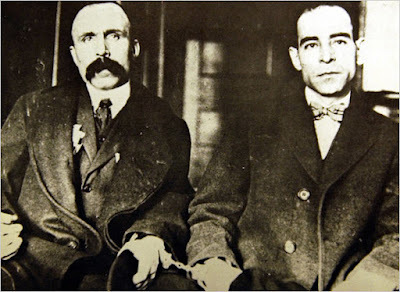 Since police and prosecutors lacked any substantial evidenceagainst the two radicals, both of whom had witnesses for their whereabouts onthe date of the crime, they went about creating it. Among the many shoe factoryworkers who managed split-second glimpses of the crime from factory windows,the state found a few whom they could pressure, or threaten, into testifyingthat they recognized the defendants. In the best of circumstances eye-witnesstestimony to the brief, violent or otherwise criminal acts of strangers ishighly unreliable. The overwhelming majority of factory workers interviewedeither said the accused were not the robbers, or they could not make anidentification based on what they had seen.
Since police and prosecutors lacked any substantial evidenceagainst the two radicals, both of whom had witnesses for their whereabouts onthe date of the crime, they went about creating it. Among the many shoe factoryworkers who managed split-second glimpses of the crime from factory windows,the state found a few whom they could pressure, or threaten, into testifyingthat they recognized the defendants. In the best of circumstances eye-witnesstestimony to the brief, violent or otherwise criminal acts of strangers ishighly unreliable. The overwhelming majority of factory workers interviewedeither said the accused were not the robbers, or they could not make anidentification based on what they had seen.
When the case went to trial, ballistic experts disagreed overwhether a bullet removed from one of the victim’s body could have been fired bySacco’s gun. Recent re-examinations of both the ballistics and autopsy evidencesuggest that the state fired a bullet from Sacco’s gun and subbed it for one ofthe bullets surgically removed from a victim’s body. Since the state failed tomaintain a secure chain of evidence, the case’s physical evidence wascontaminated.
The trial’s native-born, male jurors were themselves hardlyunbiased. After the trial, the jury foreman said he didn’t care whether thedefendants were guilty or not, saying “they should hang them all.” Itwas clear who was meant by this ‘them’ — foreigners with political beliefs thatnative-born citizens found threatening.
And trial judge Webster Thayer made his own bias clear in a widelyreported comment to a college classmate, at an alumni reunion, after passingsentence: “Did you see what I did to those anarchist bastards?”
The defendants' attorney, a respected labor lawyer naturally appealed, beginning a legal process that lasted seven years. Appeal hearings were delayed, postponed, rescheduled for a host of reasons -- so-called prosecution witnesses had left the state and needed to be tracked down. Expert witnesses were ill andcould not attend until recovery. The judge was ill for a year. The appeals court judge was ill, and then needed a vacation. When the state's supreme judiciary court finally rejected the defense's appeal, only then could Webster Thayer pronounce sentence: death in the electric chair.
The sentencing brought widespread public protests, both in this country and abroad, to a boil. A typical newspaper headline from 1927 captured the universality of working class and progressive condemnation of the court's decision:
"Protests and demonstrations and strikesall over the United States, in Germany, England Australia, Switzerland,Paraguay, Mexico, on every continent except Antarctica."
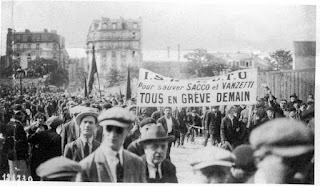 In Paris, a protest gathering drew a reported one million people.
In Paris, a protest gathering drew a reported one million people. A who’s who of prominent figuresfrom different walks of life expressed support for Sacco and Vanzetti eitherpublicly or privately. Writers Dorothy Parker and Edna St. Vincent Millay
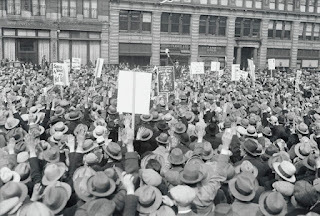
showed up to demonstrations. Benito Mussolini, then prime minister of Italy,explored potential avenues for requesting a commutation of the sentence.Various others, from Albert Einstein to George Bernard Shaw to Marie Curie,signed petitions directed toward Massachusetts Governor Alvan T. Fuller or U.S.President Calvin Coolidge.
The defendants' attorneys made a final appeal for clemency to the governor of the state. Unhappily, the overseas attention paid to the case may have worked against the defendants. Governor Alvan Fuller, a Republican, visited them in prison while weighing an appeal and was impressed by Vanzetti's personality, remarking: “what an attractive men.”
Vanzetti had used jail time to improve his English. He wrote letters to supporters, and a few memoirs. Fuller said he considered granting a pardon but, one associate explained, "He felt that worldwide interest in the case proved thatthere was a conspiracy against the United States."
Their execution, after several stays ofexecution by Fuller kept the case on the front pages in thesummer of 1927, drew international outrage, including violent demonstrations in France and in some other European countries. Thousands of people gathered the night ofthe execution, Aug. 23, 1927, many of them on the Boston Common, in a vigil…dispersing aftermidnight in sorrow after word passed that the men were dead.
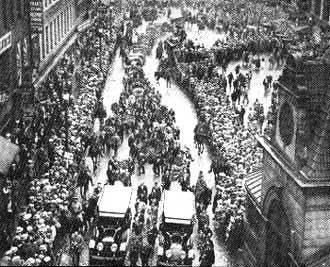
The executions also led to a huge public funeral march through thecity of Boston regarded as the largest public gathering in the city until theRed Sox World Series victory parade in 2004, with the crowd estimated bynewspapers at 200,000.
FINAL WORDS
I will give the lastwords to the two principals in this story:
"At his trial Sacco said that life in the U.S. is good forpeople with money but it’s not good for the working and the laboring class, andat his sentencing, he said, 'I know this sentencing will be between twoclasses, the rich class and the working class, and there will always becollision between one and the other.'"
Vanzetti said theirdeaths would be a worthy sacrifice. He said he mkight have spent his lifetalking to sad men on street corners, winning no change or improvements: afailure.
But “Now we are not a failure. This is our career and ourtriumph. Never in our full life can we hope to do such work for tolerance, forjustice, for man’s understanding of man as we now do by dying. Our words, ourlives, our pains—nothing! The taking of our lives—lives of a good shoemaker anda poor fish peddler—all! That last moment belongs to us—that agony is ourtriumph.”
December 5, 2023
Still Thankful: Seasonal Poems and a Time to Remember

My thanks to editor Jim Lewis for including two poems in the December issue of Verse-Virtual. The poems are a response to a seasonal request to poets to write a poem about what we're thankful for... Big question; so many, many answers.
Here's my poem --below the photo -- on gratitude for the beauty of the natural world.
Twilight in Paradise
November 13, 2023
It's a Truly Seasonal Story... If Plants Could Talk
Now that we're all in a November state of mind.... (chilly? holiday season? early dark?) ... my humorous short story "Reasoning with Azalea" is up online on Witcraft, a journal looking for ways to win a smile.
Yes, Azalea is a plant, but she does a pretty good job defending her point of view. If you click on the title, the whole piece comes up.
It's a two-minute read at most.
Here's the link Azalea
Here are the first few lines:
I know it’s cold, Azalea.
I don’t like the cold either.
But you’re not going to spend the winter indoors this year spooning with your buddy, electric heater.
Not this year.
He’ll miss me! You think you’re the reason he gets hot!
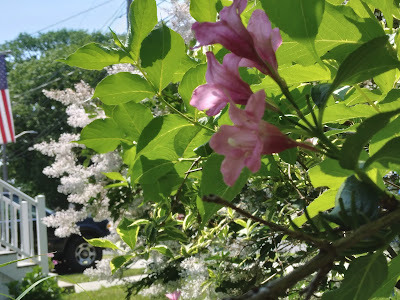
October 17, 2023
Poems in October: Seeing too much blood, too often

This past summer has been a bit of a blood bath. Damage to my bladder from long-ago prostate cancer radiation treatments has left me seeing much more of my own blood, and on a regular basis, than I ever wished to. My journey back to status quo ante (a work in in progress) has included a lot of walking at a gentler pace.
I am grateful to English poet Robert Nisbet, a frequent contributor to Verse-Virtual for his kind comments on my poems in the October issue of Verse-Virtual: "The problem with any poems about personal ailments is that they can so easily cloy, but the linguistic jauntiness of Bob Knox's first poem carries us over all of that risk. And his second poem has a real range and richness."
I have been a contributor to Verse-Virtual, a community of poets that publishes a monthly journal, since 2014 and a contributing editor since 2015.
Here are my two "bloody" poems from the October issue.
Red-Blooded AmericanBlood inside, blood outside, blood all over For days it rains red, messy, sleep-broken, unspeakable, red-basined daysThe body on a short leash,Punishment enough, I thought, for an eon of sins…Then nothing: no flow, no stream, no whisper in the cistern of the soulJust the pain of bone-dry effortsBurn, burn, the smoke of effort,no fire of release…No higher expression of the body’s deepest need than this: Gotta pee! We struggle down to the ER, dedicated spouse now designated driver – thank goodness! Or the impatient patient would have run the lightsthrough glorious, summer-green, upper-crust Milton, school-house of presidents,to a season’s early end. Succumbing (notices would read) to a deadly comboof scabs and plasma,victim of broadly fired radioactive treatments performed in a prior day by optimistic clinicians, slightly off-mark in a crowded neighborhood of organs. Somebody please, we beg the healers, free me from this inner strain. For I am bound upon a wheel of fire,an old man in a rag of flesh, who does but slenderly understand what’s bloody up.
Uphill
I walk slowly uphill.It’s how I do everything.Something has tipped the world off balance.Now the sidewalk, the dirt road, the woodland path, is always trending up.Strange… I remember thinking tasks completed, gardens planted: ‘All downhill from here.’The world is green, a healthy color.I dream of swapping flesh with the leaves that swarm the hillside, pirouetting in the devil-may-care late summer breeze.But then, in autumn’s termination, all must wither and go under…Well, yes, in the end, just a question of timing.The great shade of the foreststirs music in the minor key.I will climb these heights, once more possess such sights in a theater of the heart. My feet regain the path,reclaim their strength, their range of motion, renew my journey…both up and down.
July 3, 2023
The Garden of Verse: Doors That Never Open, and The Gates Through Which All Pass
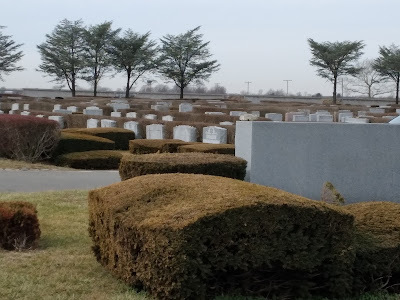
My two poems in the June 2023 issue of Verse-Virtual areboth about unusual visits, going to places where I've never been or tend toavoid.
"Other People’s Lives" tells of traveling to partsof the city in which my wife and I live in, Quincy Mass., to deliver notices ofan upcoming community meeting, and discovering that some houses are built withfront doors that are never meant to open. Here's the poem.
Other People’s LivesAll the doors closed, locked, shut up tight.No way in, no welcome mat.The mailbox up and mailed itself somewhere else.The front door an utter rampart:No entry. No welcome. Nobody home to the likes of you.Privacy protected.Living in the hills.I’m a mere stranger. Worse, afoot,no doubt out to seek thrills.Hence those locks:The feverish encounter always pre-empted.Walk your city’s hidden neighborhoods,those unseen lanes and cul-de-sacs,divorced from the city’s busy streets,its commercial thoroughfares, numbered highways.Quiet nooks, the street may not be, legally, ‘private’but a taxpayer’s home is surely his, her, or their castle…What is it like to put three-quarters of a million (probably more)into a modest lot plus extra-large dwelling, outpost of well-protected privacysmack up against a vast and wooded preserve, people-free at the busiest seasons,on a narrow street most of us commoners will never find.What is it like to hide away?This house is “Protected," so saith the conspicuous advisoryon the never-used front door.Protected in turn by all-weather storm door with its own tight lockfrom the interloper with the handbill declaring the invitation to “community meeting” –Offstage laughter indulged in silence: Community? Meeting?… preventing said interloper, or any other physical entity that can walk and chew gumfrom approaching the double-locked barrier behind it.The beast within howls his rage, his furious abandonmentwhen the interloper touches the impenetrable outer barrier,that second skin of inviolability,the offense wired directly into his self-devouring imprisonment of canine sadness. Bark all you want, Wolfie,No one is coming to reduce the terrible gnawing anxietyof your endless hours of incarceration.No toys out-of-doors, no sign any creature of flesh ever steps through this parody of ingress,the mocking shell of the conventional ‘Welcome’ baked into the unyielding mat spread upon the doorstep,the empty remembrance of that which we no longer mean to offer.Unpurposed now, its meaning fouled,it braves the elements, impersonal, dysfunctional till the very crack of doom. Speak not to us of common purpose, public space,those challenges and opportunities that onetime fell to all, … the town meeting, the charity drive.After all, who can you trust? The state is me, moi, and mine ownAnd if he, or she – or (conceivably) some trace element of younger lives –does not come home soon, I’m surely changing the locks.
The second poem, "Visiting Eternity" follow a rare visit to a place where nobody is worried about who may come to the door. Here's the poem.
Visiting Eternity
To find poems by the 48 poets represented in the June issue
of Verse-Virtual, go to
May 23, 2023
The Garden of Sad-Angry Poems: Guns and History, They're Still With Us
Two of my poems were published online last month.
My poem "They Came" was posted last month on Poetry Superhighway's 25th Annual Yom HaShoah Issue. The poem was inspired by German pastor Martin Niemöller's famous 1946 postwar writing “First They Came.”
First they came for the immigrant children
And we looked away
Because the Leader’s toady told us, “Those are not
our children”
And we looked at our own children,
and were reassured
Then they came for the people who cover their heads
or pray too much
And again we looked away
Because we were not Iranians, or Iraqis, or Gazans,
or children of the West Bank detained indefinitely without charges
And, as the man said,
those are not our children
Then they came for the abused, and those who accused their abusers,
and for the accusers’ advocates,
and for those who fought against their abusers,
But we looked away, and jested at the comedie humaine,
because we were not ourselves the victims of abuse
or the advocates for the abused,
and, after all, we were “not his type”
Then they came for the ones who would never
play ball with Der Leader
The ones who would always be trouble
because they were cheated out of their land
or, perchance, had been enslaved
or who had once owned a country that the slave-owners wished
to possess for themselves
or who, we feared, were willing to work
for too little money
or who loved the wrong people
And then because no one else remained standing
in our diminished patria,
neither advocates,
nor scribblers with their pencil over the ear,
nor Enemies of the People with their hand-held devices,
nor workers’ parties,
nor defenders of the beaten, humiliated and disappeared
nor anyone able to kick the ball from their feet,
nothing was left for us to do
but to lay our own bodies before his feet
as the painted, spiked, and horny-headed demons of extinction
cheered, and drank, and laughed, and danced upon the bodies
of their victims
and ran up history’s score
First published by The NewVerse.News in July 2019
My poem “Allen Ginsberg’s ‘America’ and Ours” was published New Verse News on April 29. This poem makes use of and takes off from Ginsberg's 1950'sbeat poem screed titled "America." His assessment of the politics ofhis day inspired me to be a little profane about our own.
Allen Ginsberg’s “America” (and Ours)
“America I’ve given you all and now I’m nothing.” – Allen Ginsberg, Howl and Other Poems, 1956
I am frankly envious of the poet who, on Jan. 17, 1956,
wrote, in a poem entitled “America,”
“America, go fuck yourself with your atom bomb.”
Tennessee, I invite, in the same spirit of candor,
go shoot yourself with your absolutely unqualified no-foolin’, stand-your-ground
irredeemably nut-case gun rights laws,
per events on the ground taking place March 28, 2023.
I could simply echo every sentiment in that mid-century poet’s inspired piece
of unbridled spontaneity
composed on the theme of his America, in which he that mid-century poet vowed,
amid other proclamations,
“I won’t write my poem till I’m in my right mind”…
but I do not expect to be in my right mind
so long as the YMCA in which I seek to run away from my fury and despair
offers news channels on its TV service available to rats like me
who run on treadmills of anger and despair
Networks, that is, on which the munitions-injury expert
is asked to describe the effect of AR ammunition on the bodies of children,
and what I increasingly wish somebody (even crazier than me) would do
to the persons of the elected Tennessee officials
who valiantly protected their freedom-loving constituents from any limitation,
however slight and publicly supported by official law enforcement,
on their natural right to destroy the bodies of children
with whatever armaments the Good Lord, acting through the protected mediation
of the National Rats Association,
entitles them to possess
“America,” Ginsberg demanded in his disarming and eternally youthful way:
“when will you take your clothes off?”
“America” – how’s this for pre-visioning the paramilitary far right? –
“why are your libraries full of tears?”
America, we ask in our hair-tearing, torn-clothing way,
Why are your courthouses, state houses, ballot boxes and school boards
full of self-made demagogues who failed to read the books
in their now besieged schoolhouses when they had the chance?
who think that libraries are merely back alleyways for the gang fights
of the culture wars?
America, we ask, why do the voters of Tennessee develop amnesia of the ballot box?
When will it end, America, your war on humanity?
When will you be worthy of your blues singers, jazzmen, street corner poets,
dancers on the page as well as on the stage?
When will you invite Stephen Colbert to be the speaker at the next inauguration?
America, the cherry trees are blossoming
and I feel sentimental about the days of wine and roses and that legendary decade ban
on assault rifles…
and even when the party of Richard Nixon was, by comparison, a beacon of moderation
Americans, we are obsessed by media, by the Chinese timebomb that goes TikTok, TikTok
America, the best minds of my generation are already underground
America, there is nobody left to vote for
America, our ancestors saved the world from fascism
But all the fascists have to do today is show their pure-white fannies on TV
and the writing on the wall goes tic-toc-clock, as the timebomb of private self-interest
melts the glaciers
and brings the ocean to your living room
just before the signoff of the foxed and phony nooz
America, you are teaching all the world how to kill people,
best result for the buck
Because that is all you remember how to do
Lilac Days in Massachusetts: The Sweet Smell of Spring


Lilac Days
They shine because this is their month,
their showtime,
but so also the cherry and other fruit trees
in their many branching varieties,
as do the dogwood, and apple, and willow,
and the nameless white-flowering beauties,
blossoms, their offerings lasting only a week or maybe, with teasing,and the right weather,
a little more.
 And the gentle sun,
And the gentle sun,Keeping its schedule, as always, to a perfection
unknown here below
slipping with matchless grace down a cloudless horizon
to the last bans of sunset, twilight
but still at night they sleep with us
still they house and keep the birds safe
in the quiethours
 and still the morning prays again
and still the morning prays againthat time persists once more to be beautiful
precisely because it is so much older than we

May All Be Blessed!*
The little fingers on the little piggies
The big men in my childhood nightmares
thumping throughthe shadows of my mind
The killers and the haters, even.
Who somehowsurvive my wrathful imaginings
as if they were nothing but what they are –
maya!
All the yoga ladies
The muscled guys
The busy life of the highway where
the machines takeus where they will
And the slow life of the late winter day –
Gleaming Marchsunshine,
Brutal west wind
And the yard full of squirrels chasing one another’s
tails
The tails wagging the dogs of peace,
The people below the bombs
The lasers of love’s eternal springtimes,
The offerings,
Those who carry the finger bowls of time
In which we dip our fingers
*(After a song by Peter Kater)

April 14, 2023
Prosegarden Goes Back to its Roots: Spring Is Starting to Shape Up
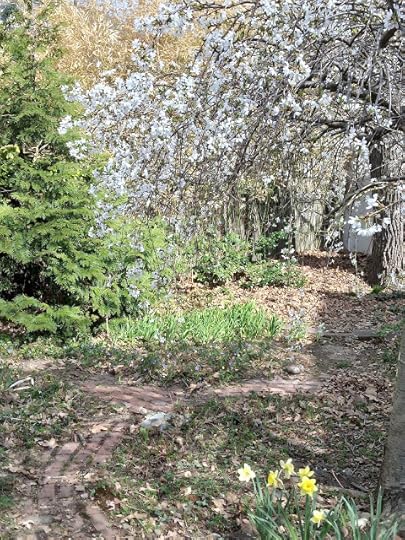
Spring is starting to shape up in our garden in Quincy, MA. The Japanese Weeping Cherry is in bloom.... But the weather has been awfully dry. I'm worried the earth won't be able to support all out plants if we don't get more rain soon.
We've had good days for April flowers. Will they bring May showers?
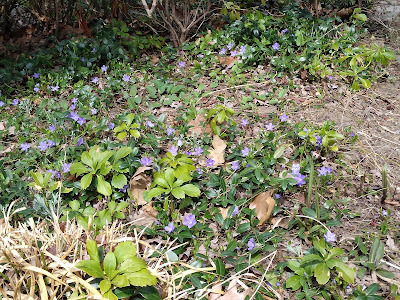
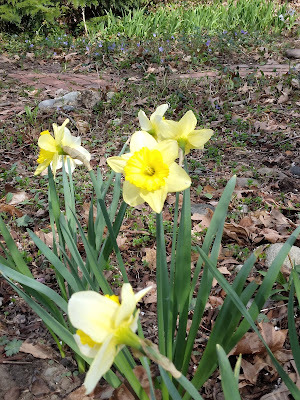
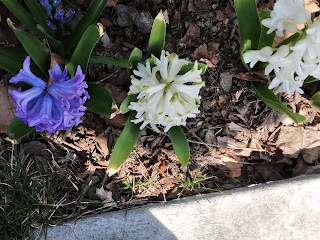
The Hyacinths are opening here, tokens of spring color. Also daffodils and Vinca.
